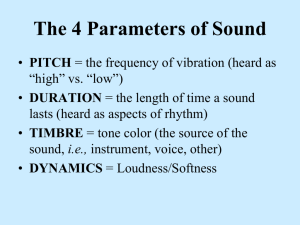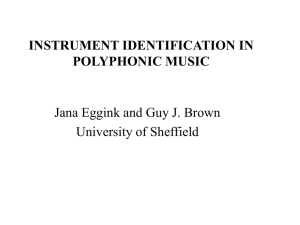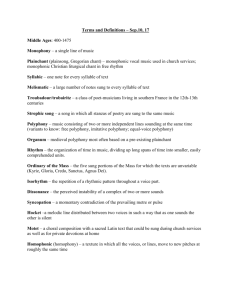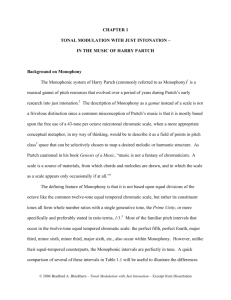Document 10677588
advertisement
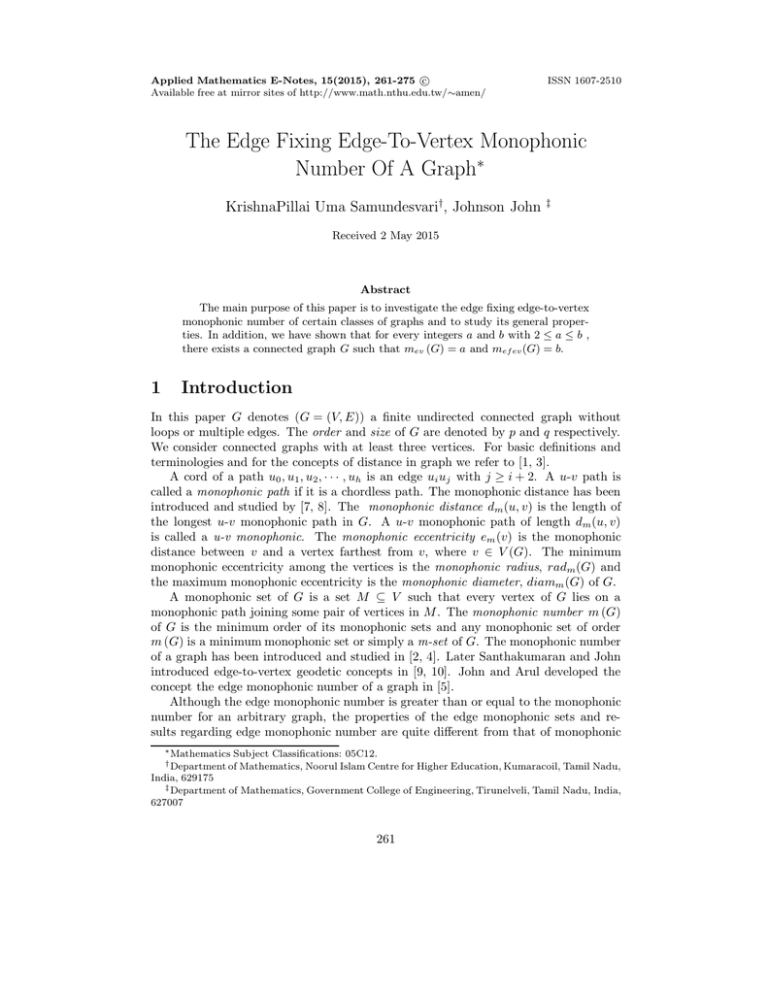
c
Applied Mathematics E-Notes, 15(2015), 261-275 Available free at mirror sites of http://www.math.nthu.edu.tw/∼amen/
ISSN 1607-2510
The Edge Fixing Edge-To-Vertex Monophonic
Number Of A Graph∗
KrishnaPillai Uma Samundesvari†, Johnson John
‡
Received 2 May 2015
Abstract
The main purpose of this paper is to investigate the edge fixing edge-to-vertex
monophonic number of certain classes of graphs and to study its general properties. In addition, we have shown that for every integers a and b with 2 ≤ a ≤ b ,
there exists a connected graph G such that mev (G) = a and mef ev (G) = b.
1
Introduction
In this paper G denotes (G = (V, E)) a finite undirected connected graph without
loops or multiple edges. The order and size of G are denoted by p and q respectively.
We consider connected graphs with at least three vertices. For basic definitions and
terminologies and for the concepts of distance in graph we refer to [1, 3].
A cord of a path u0 , u1 , u2 , · · · , uh is an edge ui uj with j ≥ i + 2. A u-v path is
called a monophonic path if it is a chordless path. The monophonic distance has been
introduced and studied by [7, 8]. The monophonic distance dm (u, v) is the length of
the longest u-v monophonic path in G. A u-v monophonic path of length dm (u, v)
is called a u-v monophonic. The monophonic eccentricity em (v) is the monophonic
distance between v and a vertex farthest from v, where v ∈ V (G). The minimum
monophonic eccentricity among the vertices is the monophonic radius, radm (G) and
the maximum monophonic eccentricity is the monophonic diameter, diamm (G) of G.
A monophonic set of G is a set M ⊆ V such that every vertex of G lies on a
monophonic path joining some pair of vertices in M . The monophonic number m (G)
of G is the minimum order of its monophonic sets and any monophonic set of order
m (G) is a minimum monophonic set or simply a m-set of G. The monophonic number
of a graph has been introduced and studied in [2, 4]. Later Santhakumaran and John
introduced edge-to-vertex geodetic concepts in [9, 10]. John and Arul developed the
concept the edge monophonic number of a graph in [5].
Although the edge monophonic number is greater than or equal to the monophonic
number for an arbitrary graph, the properties of the edge monophonic sets and results regarding edge monophonic number are quite different from that of monophonic
∗ Mathematics
Subject Classifications: 05C12.
Mathematics, Noorul Islam Centre for Higher Education, Kumaracoil, Tamil Nadu,
† Department of
India, 629175
‡ Department of Mathematics, Government College of Engineering, Tirunelveli, Tamil Nadu, India,
627007
261
262
Edge Fixing Edge-to-Vertex Monophonic Number of a Graph
concepts. These concepts have many applications in location theory and convexity
theory. There are interesting applications of these concepts with regard to the problem
of designing the route for a shuttle and communication network design. In the case of
designing the route for a shuttle, although all the vertices are covered by the shuttle
while considering monophonic sets, some of the edges may be left out. This drawback
is rectified in the case of edge monophonic sets and hence considering edge monophonic
sets is more advantageous to the real life application of routing problem. In particular, the edge monophonic sets are more useful than monophonic sets in the case of
regulating and routing the goods vehicles to transport the commodities to important
places. This is the motivation behind the introduction and study of edge-to-vertex
monophonic concepts.
In [6], we define the edge-to-vertex monophonic number of a graph and have studied
the edge-to-vertex monophonic number of standard graphs. Recently, Santhakumaran
et al. developed the concept of edge-to-vertex detour monophonic number of a graph
in [11].
1.1
Notation and Terminology
We consider finite and simple graphs and use standard terminology. For a graph G, the
vertex set is denoted by V (G) and the edge set by E(G). If e = {u, v} is an edge of a
graph G, we write e = uv, we say that e joins the vertices u and v; u and v are adjacent
vertices; u and v are incident with e. If two vertices are not joined, then we say that
they are non-adjacent. If two distinct edges e and f are incident with a common vertex
v, then e and f are said to be adjacent to each other. A set of vertices in a graph is
independent if no two vertices in the set are adjacent. A vertex of degree 0 in G is
called an end-vertex of G. A cut-vertex (cut-edge) of a graph G is a vertex and edges
whose removal increases the number of components. A vertex v is an extreme vertex
of a graph G if the subgraph induced by its neighbors is complete.
2
Preliminaries
In this section, we give definition, example and a theorem which will be used in our
main results.
DEFINITION 2.1. Let e, f ∈ E(G). The e-f monophonic path is a u-v monophonic
path where u is one end of e and v is one end of f. The vertex x is said to lie on a e − f
monophonic path if x is a vertex of e-f monophonic path. A set S ⊆ E(G) is called an
edge-to-vertex monophonic set if every vertex of G lies on a monophonic path between
two vertices in V (S). The edge-to-vertex monophonic number of G is the minimum
cardinality of its edge-to-vertex monophonic sets and is denoted by mev (G) and also
any edge-to-vertex monophonic set of cardinality mev (G) is a mev -set of G.
EXAMPLE 2.2. For the graph G given in Figure 2.1 with e = v1 v6 and f = v3 v4 ,
the e-f monophonic paths are P1 : v1 , v2 , v3 , P2 : v6 , v1 , v2 , v3 , P3 : v6 , v7 , v8 , v3 ,P4 :
v6 , v5 , v4 ,P5 : v6 , v7 , v8 , v3 , v4 , P6 : v6 , v5 , v4 , v3 , and P7 : v6 , v1 , v4 . Since the vertices
263
K. U. Samundesvari and J. John
v2 , v5 , v7 and v8 lies on the v1 v6 -v3 v4 monophonic path, S = {e, f} is a mev -set of G
so that mev (G) = 2.
v1
v2
v3
v8
v7
v6
v5
G
Figure 2.1
v4
THEOREM 2.3 ([6]). Every end-edge of a connected graph G belongs to every
edge-to-vertex monophonic set of G.
We have organized this paper in the following way. In section 3, edge fixing edgeto-vertex monophonic number of standard graphs are obtained. In Section 4, a lower
bound and upper bound for edge fixing edge-to-vertex monophonic number of a graph
is obtained. In Section 5, the realization result involving edge-to-vertex monophonic
number and edge fixing edge-to-vertex monophonic number of a graph is obtained.
3
Edge Fixing Edge - To - Vertex Monophonic Number of a Graph
We begin with the following
DEFINITION 3.1. Let e be an edge of a graph G. A set Se ⊆ E(G) − {e} is called
an edge fixing edge-to-vertex monophonic set of e of a connected graph G if every vertex
of G lies on an e-f monophonic path of G where f ∈ Se . The edge fixing edge-to-vertex
monophonic number of G is the minimum cardinality of its edge fixing edge-to-vertex
monophonic sets and is denoted by mefev (G) and also any edge fixing edge-to-vertex
monophonic set of cardinality mefev (G) is an mefev -set of G.
v7
v2
v6
v5
v1
v3
v4
G
Figure 3.1
EXAMPLE 3.2. For the graph given in Figure 3.1, the edge fixing edge-to-vertex
monophonic set is given in the following Table 3.1.
264
Edge Fixing Edge-to-Vertex Monophonic Number of a Graph
Fixing Edge (e)
v1 v7
v6 v7
v2 v5
v2 v7
v1 v2
v3 v4
v6 v5
v4 v5
v2 v3
Minimum Edge Fixing edge-to-vertex
monophonic sets (Se )
{v3 v4 } , {v4 v5 }
{v3 v4 , v1 v2 } , {v2 v3 , v1 v2 } , {v6 v5 , v1 v2 },
{v1 v7 , v3 v4 } , {v4 v5 , v1 v7 } , {v2 v3 , v1 v7 }
{v1 v7 , v3 v4 } , {v1 v2 , v3 v4 }
{v1 v7 , v3 v4 } , {v1 v2 , v3 v4 }
{v3 v4 }
{v1 v7 } , {v1 v2 }
{v1 v2 , v3 v4 } , {v1 v7 , v3 v4 }
{v1 v7 } , {v1 v2 }
{v1 v7 }
mefev (G)
1
2
2
2
1
1
2
1
1
Table 3.1
REMARK 3.3. For a connected graph G, the edge e of G does not belong to edge
fixing edge-to-vertex monophonic set Se .
THEOREM 3.4. Let e be an edge of G and let v be an extreme vertex of a
connected graph G such that v is not incident with e. Then every edge fixing edgeto-vertex monophonic set of e of G contains at least one extreme edge that is incident
with v irrespective of the fact whether e is an extreme edge or not.
PROOF. Let e1 , e2 , · · · , ek be the edges incident with v and let Se be any edge fixing
edge-to-vertex monophonic set of e of G. We claim ei ∈ Se for some i (1 ≤ i ≤ k). Let
us assume that ei ∈
/ Se for all i(1 ≤ i ≤ k). Since Se is an edge fixing edge-to-vertex
monophonic set of e of G, the vertex v lies on the monophonic path joining a vertex,
say x, incident with e and y ∈ V (Se ). Since v is an internal vertex of a monophonic
path x-y, v is not an extreme vertex of G, which is a contradiction. Hence ei ∈ Se for
some i (1 ≤ i ≤ k).
COROLLARY 3.5. Every end-edge of a connected graph G belongs to every edge
fixing edge-to-vertex monophonic set of an edge e of G.
THEOREM 3.6. Let G be a connected graph and Se be an edge fixing edge-tovertex monophonic set of e of G. Let f be a cut-edge of G, which is not an end-edge
of G and let G1 and G2 be the two components of G − {f}.
(i) If e = f, then each of the two components of G − {f} contains an element of Se .
(ii) If e 6= f, then Se contains at least one edge of components of G − {f} where e
does not lie.
PROOF. Let f = uv. Let G1 and G2 be the two components of G − {f} such that
u ∈ V (G1 ) and v ∈ V (G2 ).
265
K. U. Samundesvari and J. John
(i). Let e = f. Suppose that Se does not contain any element of G1 . Then
0
Se ⊆ E(G2 ). Let h be an edge of E(G1 ). Then h lies in e-f monophonic path
0
P : v, v1 , v2 , . . . , vl , v, u, u1, u2, . . . , us , u, v, v1 , v2 , . . . , v ,
0
0
where v1 , v2 , . . . , vl ∈ V (G2 ), u1 , u2 , . . . , us ∈ V (G1 ) and v is end of f . Since u, v lies
in P more than once, P is not a path, which is a contradiction. Hence each of the two
components of G − {f} contains an element of Se .
(ii). By similar arguments, we can prove that if e 6= f, then Se contains at least
one edge of component of G − {f} where e does not lie.
THEOREM 3.7. Let G be a connected graph and Se be a minimum edge fixing
edge-to-vertex monophonic set of an edge e of G. Then no cut-edge of G which is not
an end-edge of G belongs to Se .
PROOF. Let Se be an edge fixing edge-to-vertex monophonic set of an edge e = uv
of G. Let f = u0 v0 be a cut-edge of G which is not an edge of G such that f ∈ Se .
If e = f, then by definition of edge fixing edge-to-vertex monophonic set of an edge e
of G, f ∈
/ Se . If e 6= f, let G1 and G2 be the two components of G − {f} such that
u0 ∈ V (G1 ) and v0 ∈ V (G2 ). By Theorem 3.6, G1 contains an edge xy and G2 contains
0 0
0 0
0
0
an edge x y , where xy, x y ∈ Se . Let Se = Se − {f}. We claim that Se is an edge
fixing edge-to-vertex monophonic set of an edge e of G.
0
0
Case 1. Suppose that e = xy is an edge in G1 and x y is an edge in G2 .
Let z be any vertex of G. Assume without loss of generality that z belongs to G1 .
Since u0 v0 is a cut-edge of G2 , every path joining a vertex of G1 with a vertex of
G2 contains the edge u0 v0 . Suppose that z is incident with u0 v0 or the edge xy of
Se or that lies on a monophonic path joining xy and u0 v0 . If z is incident with
u0 v0 , then z = u0 . Let P : y, y1 , y2 , · · · , z = u0 be a xy-u0 monophonic
n 0path.
o Let
0
0
0
0 0
0
Q : v10 , v2 , · · · , y be a v0 y monophonic path. Then, it is clear that P ∪ u v ∪ Q is
0
0
0
0
a xy-x y monophonic path .Thus z lies on the xy-x y monophonic path. If z is inci0 0
dent with xy, then there is nothing to prove. If z lies on a xy-x y monophonic path,
0
0
0
0
0
0
0 0
say y, v1 , v2 , · · · , z, . . . , u , then let v , v1 , v2 , · · · , y be v -x y monophonic path. Then
0
0
0
0
0
0 0
clearly y, v1 , v2 , · · · , z, · · · , u , v , v1 , v2 , · · · , y is a xy-x y monophonic path. Thus z
0
lies on a monophonic path joining a pair of edges of Se . Hence we have proved that a
0 0
vertex that is incident with u v or an edge of Se or that lies on a monophonic path
0 0
0
joining xy and u v of Se also is incident with an edge of Se or lies on a monophonic
0
0
path joining a pair of edges of Se . Therefore it follows that
S e is an edge fixing edge 0
to-vertex monophonic set of an edge e of G such that Se = |Se | − 1, which is a
contradiction to Se a mefev - set of G.
Case 2. Suppose that e = xy ∈ G2 .
The proof is similar to that of Case 1.
THEOREM 3.8. For any non-trivial tree T with k end-edges,
k − 1 if e is an end-edge of G,
mefev (G) =
k
if e is an internal edge of G.
266
Edge Fixing Edge-to-Vertex Monophonic Number of a Graph
PROOF. This follows from Corollary 3.5 and Theorem 3.7.
THEOREM 3.9. For the cycle graph G = Cp (p ≥ 4) , mefev (G) = 1, for every edge
in E(G).
PROOF. Let G = Cp be a cycle graph and e be an edge of G. Let f be an edge of G,
which is independent of e. Let Se = {f} be an edge fixing edge-to-vertex monophonic
set of an edge e of G so that mefev (G) = 1.
THEOREM 3.10. For the complete graph Kp (p ≥ 4) with p even, mefev (G) =
for every edge in E(G).
p−2
2 ,
PROOF. Let G = Kp be a complete graph Kp (p ≥ 4) and e be an edge of G. Let Se
be any set of p−2
/ Se . Since each vertex of Kp is
2 independent edges of Kp such that e ∈
either incident with an edge of Se or incident with e, Se is an edge fixing edge-to-vertex
monophonic set of an edge e of G. Hence it follows that
mefev (G) ≤
p−2
.
2
p−2
2 ,
then there
exists an edge fixing edge-to-vertex monophonic set
0
p−2
Se of e of Kp such that Se < 2 . Therefore, there exists at least one vertex v of
If mefev (G) <
0
0
Kp such that v is not incident with any edge of Se . Hence v is neither incident with
0
0
0
any edge of Se nor lies on a monophonic path e-f where f ∈ Se and so Se is not an
edge fixing edge-to-vertex monophonic set of an edge e of G, which is a contradiction.
Thus Se is an edge fixing edge-to-vertex monophonic set of an edge e of Kp . Hence
mefev (G) = p−2
2 .
THEOREM 3.11. For the complete graph G = Kp (p ≥ 5) with p odd,
mefev (Kp ) =
p−1
for every edge in E(G).
2
PROOF. Let G = Kp be a complete graph Kp (p ≥ 5). Let e be an edge of G and
0
let Me consist of any set of p−5
/ Se and Me
2 independent edges of Kp such that e ∈
consist of 2 adjacent edges of Kp , each of which is independent with the edges of Me .
0
Let Se = Me ∪ Me . Since each vertex of Kp is either incident with an element of Se or
incident with e, Se is an edge fixing edge-to-vertex monophonic set of an edge e of G.
Hence it follows that
p−5
p−1
mefev (G) ≤
+2 =
.
2
2
If mefev (G) <
p−1
2 ,
0
then there exists an edge fixing edge-to-vertex monophonic set Se
0
of Kp such that Se < p−1
2 . Therefore, there exists at least one vertex v of Kp such
0
that v is not incident with any edge of Se . Hence the vertex v is neither incident with
0
0
0
any edge of Se nor lies on a monophonic path e-f where f ∈ Se and so Se is not an
edge fixing edge-to-vertex monophonic set of an edge e of G, which is a contradiction.
K. U. Samundesvari and J. John
267
Thus Se is an edge fixing edge-to-vertex monophonic set of an edge e of Kp . Hence
mefev (Kp ) = p−1
2 .
THEOREM 3.12. For the complete bipartite graph G = Km,n (2 ≤ m ≤ n),
mefev (G) = 1, for every edge in E(G).
PROOF. Let G = Km,n (2 ≤ m ≤ n) be the complete bipartite graph. Let
X = {x1 , x2 , · · · , xm } and Y = {y1 , y2 , · · · , yn }
be the bipartition of G. Let e be any edge of G and let Se = {f}, where e 6= f. Let
e = xi yj and f = xk yl ,
where 1 ≤ i, k ≤ m, and 1 ≤ j, l ≤ n such that i 6= k and j 6= l. Let x be any vertex
of G. If x ∈ Y , then x lies on the monophonic path xi -xk . If x ∈ X, then x lies on the
monophonic path yj -yl . Hence Se is an edge fixing edge-to-vertex monophonic set of
an edge e of G so that mefev (G) = 1.
4
Results on Edge Fixing Edge-to-Vertex Monophonic
Number of a Graph
THEOREM 4.1. Let G be a connected graph with at least three vertices. Then
1 ≤ mefev (G) ≤ q − 1.
PROOF. For an edge e, an edge fixing edge-to-vertex monophonic set needs at least
one edge of G so that mefev (G) ≥ 1. For an edge e ∈ E(G), E(G) − {e} is an edge
fixing edge-to-vertex monophonic set of an edge e of G so that mefev (G) ≤ q − 1.
Therefore 1 ≤ mefev G) ≤ q − 1.
REMARK.4.2. For the cycle G = Cp (p ≥ 4), for an edge e, any edge which is
independent of e is its minimum edge fixing edge-to-vertex monophonic set of e of
G so that mefev (G) = 1. For the star G = K1,q , for an edge e, the set of edges
E(G) − {e} is the unique edge fixing edge-to-vertex monophonic set of e of G so that
mefev (G) = q − 1. Thus the star K1,q has the largest possible edge fixing edge-tovertex monophonic number q − 1 and the cycle Cp (p ≥ 4) has the smallest edge fixing
edge-to-vertex monophonic number 1.
THEOREM 4.3. Let G be a connected graph so that G is neither a star nor a
double star. Then mefev (G) ≤ q − 2 for every e ∈ E(G).
PROOF. We consider two cases.
Case 1. Suppose that G is a tree such that G is neither a star nor a double star.
Then by Theorem 3.8, mefev (G) ≤ q − 2 for every e ∈ E(G).
Case 2. Suppose that G is not a tree. Then G contains at least one cycle, say,
C. Let e be an edge of G and let Se = E(G) − {e, f}, where f is an edge of C such
268
Edge Fixing Edge-to-Vertex Monophonic Number of a Graph
that f 6= e. Then Se is an edge fixing edge-to-vertex monophonic set of e of G so that
mefev (G) ≤ q − 2.
So by Cases 1–2, we prove Theorem 4.3.
THEOREM 4.4. Let G be a connected graph and e ∈ E(G). Then mefev (G) = q −1
if and only if e is an edge of K1,q or e is an internal edge of a double star.
PROOF. Let G be a connected graph. If e is an edge of K1,q , then by Theorem
3.8, mefev (G) = q − 1. If e is an internal edge of a double star, then by Theorem 3.8,
mefev (G) = q −1. Conversely, let mefev (G) = q −1 for an edge e ∈ E(G). Suppose that
e is neither an edge of K1,q nor an internal edge of a double star. Then by Theorem
4.3, mefev (G) ≤ q − 2, which is a contradiction.
THEOREM 4.5. Let G be a connected graph with q ≥ 4, which is not a cycle and not
a tree and let C(G) be the length of the longest cycle. Then mefev (G) ≤ q − C(G) + 1.
PROOF. Let C(G) denote the length of the longest cycle in G and C the cycle of
length of C(G). We consider two cases.
Case 1. C(G) is odd.
Subcase 1a. C(G) = 3. Let C : v1 , v2 , v3 , v1 be a cycle of length three.
Since G is not a cycle, there exists a vertex v in G such that v is not a vertex of C and
which is adjacent to v1 . Let e = v1 v be an edge of G such that e is not an edge of C
and let
Se = E(G) − {v1 v2 , v1 v3 } − {e} .
Clearly Se is an edge fixing edge-to-vertex monophonic set of e of G so that
mefev (G) ≤ q − 3 = q − C(G) < q − C(G) + 1.
Suppose that e = v2 v3 is an edge of G such that e ∈ E(C). Let
Se = E(G) − {v1 v2 , v1 v3 } − {e} .
Then Se is an edge fixing edge-to-vertex monophonic set of e of G so that
mefev (G) ≤ q − 3 = q − C(G) < q − C(G) + 1.
Subcase 1b. C(G) ≥ 5. Let
C : v1 , v2 , · · · , vk , vk+1 , · · · , v2k+1, v1
be a cycle of length C(G) = 2k + 1, k ≥ 2. Since G is not a cycle, there exists a vertex
v in G such that v is not a vertex of C and which is adjacent to v1 , say. Let e be an
edge of G but not in E(C). Let
Se = {E(G) − E(C)} ∪ {vk+1 vk+2 } .
Clearly Se is an edge fixing edge-to-vertex monophonic set of e of G so that mefev (G) ≤
q − C(G) + 1. Suppose that e is an edge of both G and C, and which is incident with
v1 . Let
Se = {E(G) − E(C)} ∪ {vk+1 vk+2 } .
K. U. Samundesvari and J. John
269
Then Se is an edge fixing edge-to-vertex monophonic set of e of G so that
mefev (G) ≤ q − C(G) + 1.
Caes 2. C(G) is even.
Subcase 2a. C(G) = 4. Let C : v1 , v2 , v3 , v4 , v1 be a cycle of length 4. Since G is
not a cycle, there exists a vertex v in G but not a vertex of C and which is adjacent to
v1 , say. Let e = v1 v be an edge of G but not in E(C). Let
Se = E(G) − {v1 v2 , v1 v4 , v2 v3 } − {e} .
Clearly Se is an edge fixing edge-to-vertex monophonic set of e of G so that
mefev (G) ≤ q − 4 = q − C(G) < q − C(G) + 1.
Suppose that e is an edge of G which is incident with v1 and also an edge of C. Let
Se = E(G) − {v2 v3 , v1 v4 } − {e} .
Clearly Se is an edge fixing edge-to-vertex monophonic set of e of G so that
mefev (G) ≤ q − 3 = q − C(G) + 1.
Subcase 2b. C(G) ≥ 6. Let
C : v1 , v2 , · · · , vk , vk+1 , · · · , v2k , v1
be a cycle of length C(G) = 2k, k ≥ 2. Since G is not a cycle, then there exists a vertex
v in G such that v is not a vertex of C and which is adjacent to v1 , say. Let e be an
edge of G but not in E(C). Let
Se = {E(G) − E(C)} ∪ {vk vk+1 } .
Clearly Se is an edge fixing edge-to-vertex monophonic set of e of G so that mefev (G) ≤
q − C(G) + 1. Suppose that e is an edge of both G and C, and which is incident with
v1 . Let
Se = {E(G) − E(C)} ∪ {vk vk+1 } .
Then Se is an edge fixing edge-to vertex monophonic set of e of G so that mefev (G) ≤
q − C(G) + 1.
Thus mefev ≤ q − C(G) + 1.
THEOREM 4.6. Let G be a connected graph which is not a double star with
mefev (G) = q − 2 for some edge e of G. Then G is unicycle.
PROOF. Suppose that G is not unicycle. Then G contains more than one cycle.
Let C1 and C2 be the two cycles of G. By Theorem 4.5, |C1 | = |C2 | = 3.
Case 1. Suppose that C1 and C2 have exactly one vertex, say v in common. Let
C1 : v, v1 , v2 and C2 : v, u1 , u2 be two cycles.
270
Edge Fixing Edge-to-Vertex Monophonic Number of a Graph
Subcase 1a. Let e = v1 v2 be an edge of C1 and let
Se = E(G) − {e, vv1 , vv2 , vu1 , vu2 } .
Then Se is an edge fixing edge-to-vertex monophonic set of e of G so that mefev (G) ≤
q − 5, which is a contradiction.
Subcase 1b. Let e = vv1 be an edge of C1 and let
Se = E(G) − {e, vu1 , vu2 , f}
where f ∈ E(C1 ) such that f = v1 v2 or vv2 .Then Se is an edge fixing edge-to-vertex
monophonic set of e of G so that mefev (G) ≤ q − 4, which is a contradiction.
Subcase 1c. Let e = u1 u2 be an edge of C2 and let
Se = E(G) − {e, vv1 , vv2 , vu1 , vu2 } .
Then Se is an edge fixing edge-to-vertex monophonic set of e of G so that mefev (G) ≤
q − 5, which is a contradiction.
Subcase 1d. Let e = vu1 be an edge of C2 and let
Se = E(G) − {e, vv1 , vv2 , g}
where g ∈ E(C2 ) such that g = u1 u2 or vu2 .Then Se is an edge fixing edge-to-vertex
monophonic set of e of G so that mefev (G) ≤ q − 4, which is a contradiction.
Case 2. Suppose that C1 and C2 have a common edge,say uv. Let C1 : u, v, v1 and
C2 : u, v, u1 be two cycles.
Subcase 2a. Let e = uv be an edge of G and let Se = E(G) − {e, f, g}, where
f ∈ E(C1 ) and g ∈ E(C2 ) such that f = uu1 or vv1 and g = uu1 or vu1 . Then Se is an
edge fixing edge-to-vertex monophonic set of e of G so that mefev (G) ≤ q − 3, which
is a contradiction.
Subcase 2b. Let e = vv1 be an edge of C1 and let
Se = E(G) − {e, uv, uv1 , uv2 } .
Then Se is an edge fixing edge-to-vertex monophonic set of e of G so that mefev (G) ≤
q − 4, which is a contradiction.
Subcase 2c. Let e = vu1 be an edge of C2 and let
Se = E(G) − {e, uv, uu1 , vv1 } .
Then Se is an edge fixing edge-to-vertex monophonic set of e of G so that mefev (G) ≤
q − 4, which is a contradiction.
So by Cases 1–2, we have proved Theorem 4.6.
THEOREM 4.7. For a connected graph G, mev (G) ≤ mefev (G) + 1.
PROOF. Let e be an edge of G and Se be the minimum edge fixing edge-to-vertex
monophonic set of e of G. Then Se ∪ {e} is an edge-to-vertex monophonic set of e of
G so that
mev (G) ≤ |Se ∪ {e}| = mefev (G) + 1.
271
K. U. Samundesvari and J. John
REMARK 4.8. The bounds in Theorem 4.7 is sharp. For the cycle Cp, mefev (Cp ) =
1 but mev (Cp ) = 2. Also the inequality in the Theorem is strict. For the graph G,
given in Figure 4.1, let e = {u4 u7 } and Se = {u1 u2 , u5 u6 } be an edge fixing edgeto-vertex monophonic set of e of G so that mefev (G) = 2 and mev (G) = 2. Hence
mev (G) < mefev (G) + 1.
u2
u5
u3
u4
u1
u8
u9
u7
5
u6
G
Figure 4.1
Realization Result
THEOREM 5.1. For positive integers rm , dm and l ≥ 2 with rm < dm ≤ 2rm , there
exists a connected graph G with radm G = rm , diamm G = dm and mefev (G) = l or
l − 1, for every e ∈ E(G).
PROOF. When rm = 1, G = K1,l . Then the result follows from Corollary 3.8. Let
rm ≥ 2. Let Cr+2 : v1 , v2 , · · · , vr+2 be a cycle of length r + 2 and let
Pdm −r+1 : u0 , u1, u2 , · · · , udm −r
be a path of length dm − rm + 1. Let H be a graph obtained from Cr+2 and Pdm −r+1
by identifying v1 in Cr+2 and uo in Pdm −r+1 . Now add new vertices l − 1, viz,
w1 , w2 , · · · , wl−2 to H and join each wi (1 ≤ i ≤ l − 2) to the vertex udm −r−1 and
obtain the graph G of Figure 5.1. Then radmG = rm and diamm G = dm . Let
Se = {udm −r−1 w1 , udm −r−1 w2 , · · · , udm −r−1 wl−2 , udm −r−1 udm −r }
be the set of all end-edges of G.
v2
v3
v4
v1 = u0 u1
Cr+2
udm−r
udm−r−2 udm−r−1
u2
vr
w1
vr+1
wl−2
w2
vr+2
G
Figure 5.1
Case 1. Suppose that e ∈ Se . By Corollary 3.5, Se − {e} is a subset of every edge
fixing edge-to-vertex monophonic set of e of G. It is clear that Se − {e} is not an edge
fixing edge-to-vertex monophonic set of e of G so that mefev (G) ≥ l − 2. However, the
set {Se − {e}} ∪ {f}, where
f ∈ {v2 v3 , v3 v4 , . . . , vr+1 vr+2 }
272
Edge Fixing Edge-to-Vertex Monophonic Number of a Graph
is an edge fixing edge-to-vertex monophonic set of e of G so that
mefev (G) = l − 2 + 1 = l − 1.
Case 2. Suppose that e ∈
/ Se .
Subcase 2a. Let
e = ui uj (0 ≤ i ≤ udm −r−1 , 1 ≤ j ≤ udm −r−1 ) .
By Corollary 3.5, Se is a subset of every edge fixing edge-to-vertex monophonic set of
e of G. It is clear that Se is not an edge fixing edge-to-vertex monophonic set of e of
G so that mefev (G) ≥ l. However Se ∪ {f} where
f ∈ {v2 v3 , v3 v4 , . . . , vr+1 vr+2 }
is an edge fixing edge-to-vertex monophonic set of e of G so that mefev (G) = l−1+1 = l.
Subcase 2b. Suppose that
e 6= ui uj (0 ≤ i ≤ udm −r−1 , 1 ≤ j ≤ udm −r−1 ) .
If e = v1 v2 , then by Corollary 3.5, Se is a subset of every edge fixing edge-to-vertex
monophonic set of e of G. It is clear that Se is not an edge fixing edge-to-vertex
monophonic set of e of G so that mefev (G) ≥ l. However Se ∪ {f} where
f ∈ {v3 v4 , v4 v5 , . . . , vr+1 vr+2 }
is an edge fixing edge-to-vertex monophonic set of e of G so that mefev (G) = l−1+1 = l.
If e = v1 vr+2 ,then by Corollary 3.5, Se is a subset of every edge fixing edge-to-vertex
monophonic set of e of G. It is clear that Se is not an edge fixing edge-to-vertex
monophonic set of e of G so that mefev (G) ≥ l. However Se ∪ {f} where
f ∈ {v2 v3 , v3 v4 , . . . , vr vr+1 }
is an edge fixing edge-to-vertex monophonic set of e of G so that mefev (G) = l−1+1 = l.
If e 6= v1 v2 and v1 vr+2 , then by Corollary 3.5, Se is a subset of every edge fixing edgeto-vertex monophonic set of e of G. It is clear that Se is an edge fixing edge-to-vertex
monophonic set of e of G so that mefev (G) = l − 1.
Hence mefev (G) = l or l − 1, for every e ∈ E(G).
THEOREM 5.2. For any positive integer a, 1 ≤ a ≤ q − 1, there exists a connected
graph G of size q such that mefev (G) = a, for some edge e ∈ E(G).
PROOF. Let G be a connected graph. We consider three cases.
Case 1. a = q − 1. For the star G = K1,q , by Theorem 3.8, we see that mefev =
q − 1 = a for every edge e ∈ E(G).
Case 2. a = 1. Let G be a path of length q and e be an end edge of G. Then by
Theorem 3.8, mefev = 1 = a.
K. U. Samundesvari and J. John
273
Case 3. 1 < a < q − 1. Let G be a tree with a end edges and q − a internal edges
and let e be an internal edge of G. Then by Theorem 3.8, mefev (G) = a.
So by Cases 1–3, we have proved Theorem 5.2.
In view of Theorem 4.7, we have the following realization.
THEOREM 5.3. For every pair of positive integers with 2 ≤ a ≤ b, there exists a
connected graph G such that mev (G) = a and mefev (G) = b, for some edge e ∈ E(G).
PROOF. Let G be a connected graph. We consider two cases.
Case 1. a = b. Let G be a double star with a end edges and let e be a cut - edge
of G. Then by Theorem 3.8, mefev (G) = a. Also by Theorem 2.3, mev (G) = b.
Case 2. 2 ≤ a < b. Let G be a graph obtained from the path on three vertices
P : u1 , u2 , u3 by adding a − 2 new vertices z1 , z2 , · · · , za−2 and joining each zi (1 ≤ i ≤
a − 2) with u2 . And also adding b − a + 2 new vertices v1 , v2 , · · · , vb−a+2 and a new
vertex x and also joining each vi (1 ≤ i ≤ b − a + 2) and x with u1 and u3 . The graph
G is shown in Figure 5.2.
First we show that mev (G) = a. Let S = {z1 u2 , z2 u2 , · · · , za−2 u2 } be the set of
all end-edges of G. By Theorem 2.3, S is a subset of every edge-to-vertex monophonic
set of G. It is clear that S is not an edge-to-vertex monophonic set of G so that
mev (G) ≥ a − 2. It is easily verified that S ∪ {f} where f ∈
/ S, is not an edge-to-vertex
0
monophonic set of G. However, S = S ∪ {u1 u2 , u2u3 } be the set of all edge-to-vertex
monophonic set of G so that mev (G) = a. Let e = xu3 . By Corollary 3.5, Se =
{z1 u2 , z2 u2 , · · · , za−2 u2 } is a subset of every edge fixing edge-to-vertex monophonic set
of e of G. It is clear that Se is not an edge fixing edge-to-vertex monophonic set of e
of G. Let
Wi = {u1 vi , u3 vi } (1 ≤ i ≤ b − a + 2).
It can be observed that every edge fixing edge-to-vertex monophonic set Se of G contains at least one edge from Wi (1 ≤ i ≤ b − a + 2) and so
mefev (G) ≥ a − 2 + b − a + 2 = b.
Now
0
Se = Se ∪ {u1 v1 , u1v2 , · · · , u1 vb−a+2 }
is an edge fixing edge-to-vertex monophonic set of e of G so that mefev (G) = b.
274
Edge Fixing Edge-to-Vertex Monophonic Number of a Graph
z1
z2
za−2
u1
u3
u2
e
x
v1
v2
vb−a+2
G
Figure 5.2
Acknowledgement. The authors are thankful to the reviewers for valuable comments and kind suggestions.
References
[1] F. Buckley and F. Harary, Distance in Graphs, Addison-Wesley Publishing Company, Advanced Book Program, Redwood City, CA, 1990.
[2] Esamel M. paluga, Sergio R. Canoy, Jr., Monophonic numbers of the join and
composition of connected graphs, Discrete Math., 307(2007), 1146–1154.
[3] F. Harary, Graph Theory, Addison-Wesley Publishing Co., Reading, Mass.-Menlo
Park, Calif.-London 1969.
[4] Mitre C. Dourado, Fabio protti and Jayme. L. Szwarcfiter, Algorithmic aspects
of monophonic convexity, The IV Latin-American Algorithms, Graphs, and Optimization Symposium, 177–182, Electron. Notes Discrete Math., 30, Elsevier Sci.
B. V., Amsterdam, 2008.
[5] J. John and P. A. P. Sudhahar, On the edge-monophonic number of a graph,
Filomat, 26(2012), 1081–1089.
[6] J. John and K. U. Samundesvari, The edge-to-vertex monophonic number of a
graph, International Journal of Mathematical Archive, 3(2012) 722 -728
[7] A. P. Santhakumaran and P. Titus, Monophonic distance in graphs, Discrete Math.
Algorithms Appl., 3(2011), 159–169.
[8] A. P. Santhakumaran and P. Titus, A note on monophonic distance in graphs,
Discrete Math. Algorithms Appl., 4(2012), 1250018, 5 pp.
[9] A. P. Santhakumaran and J. John, The edge-to-vertex geodetic number of a graph,
Miskolc Math. Notes, 13(2012), 107–119.
K. U. Samundesvari and J. John
275
[10] A. P. Santhakumaran and J. John, On the edge-to-vertex geodetic number of a
graph, Miskolc Math. Notes, 13(2012), 107–119.
[11] A. P. Santhakumaran, P. Titus and K. Ganesamoorthy, Edge-to-vertex detour
monophonic number of a graph, Rom. J. Math. Comput. Sci., 4(2014), 180–188.


